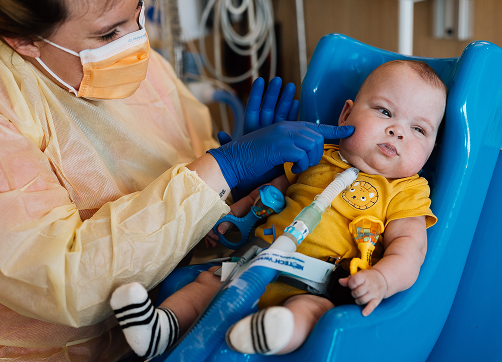biliary atresia


what is biliary atresia?
Biliary atresia is a condition that affects the liver and bile ducts. Biliary atresia is a rare disease that occurs in about one in 12,000 infants in the U.S. Symptoms usually start between two to eight weeks after birth.
With biliary atresia there is scarring on the bile ducts. Bile ducts carry bile from the liver to the intestine. Bile is an important fluid for digesting food. When bile cannot get out of the liver it causes damage. Damaging the liver can cause liver failure. The cause of biliary atresia is unknown.
how is biliary atresia diagnosed?
Babies with biliary atresia usually seem healthy when they are born. Symptoms of biliary atresia can include:
- Jaundice – a yellow color that can be seen on the skin and eyes. Jaundice is caused by a high level of bilirubin in the blood. Bilirubin is a bile pigment. Jaundice is a common condition in newborns. It usually goes away within the first week to 10 days after birth. A baby with biliary atresia continues to have jaundice or develops jaundice two to three weeks after birth.
- White or clay colored stools (also called acholic stools) – bile is what gives poop its normal green or brown color. Without bile being emptied into the intestine, the poop loses its color and can look white or gray.
- Dark urine – caused by the increase in bilirubin in the blood. The kidneys begin to filter the bilirubin and remove it in the urine.
- Poor growth or weight loss – the lack of bile can affect absorption of fat and affect nutrition, which can lead to growth problems.
- Irritability – jaundice can also cause the baby to be uncomfortable.
Because babies can have these symptoms due to different conditions, diagnosing biliary atresia requires testing. Some of these tests include:
- Blood tests will show abnormalities in liver function. A blood test will provide clues about the cause of the jaundice.
- Abdomen ultrasound may show us if there is an abnormal sized gallbladder or no gallbladder at all. If the baby is born without a gallbladder this usually means biliary atresia.
- A liver biopsy is a test where we take a tiny sample of the liver with a needle. The sample is looked at under a microscope. The sample can help us determine why the baby has jaundice and biliary atresia is the cause.
- Diagnostic surgery is done when the doctors believe there is a high likelihood of biliary atresia. The surgery includes putting a dye into the bile duct to see if there is a blockage.


how is biliary atresia treated?
TrBiliary atresia is treated with surgery. The surgery is called a Kasai procedure. The Kasai procedure is done to improve bile flow from the liver into the intestine. The surgeon will remove the damaged parts of the bile duct and identify smaller ducts that are still working correctly. The surgeon will connect the working bile ducts to the intestines. In many babies this connection allows bile to flow like it should in a healthy biliary system.
how will the Kasai procedure affect my baby?
After surgery, babies are usually in the hospital for seven to 10 days. Antibiotics will be given to decrease the risk of infection. Other medicines may be given to increase correct bile flow.
The Kasai procedure is not a cure for biliary atresia. If successful, the surgery allows babies to grow and have good health for several years. The Kasai procedure is not a permanent fix. Many children will require a liver transplant later in life when they are older and bigger.

find a provider
related blogs
here when you need us
Whether you’re looking for the right provider, ready to make an appointment, or need care right now—we’re here to help you take the next step with confidence.

